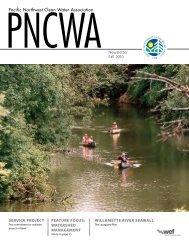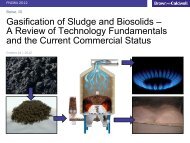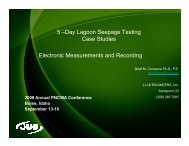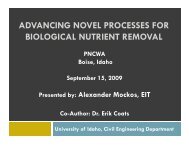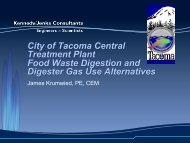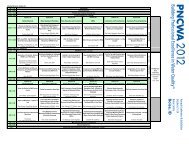Maximizing Secondary Wet Weather Treatment Capacity at ... - pncwa
Maximizing Secondary Wet Weather Treatment Capacity at ... - pncwa
Maximizing Secondary Wet Weather Treatment Capacity at ... - pncwa
You also want an ePaper? Increase the reach of your titles
YUMPU automatically turns print PDFs into web optimized ePapers that Google loves.
Two <strong>Wet</strong> <strong>We<strong>at</strong>her</strong> Oper<strong>at</strong>ing Modes<br />
Step feed with RAS Storage is provided for use during large rain events<br />
• Upstream feed point shifted to zone 2<br />
• Provides storage of RAS to protect inventory from washout<br />
• Further reduces clarifier solids loading r<strong>at</strong>e<br />
RAS<br />
1 2 3 4 5 6 7<br />
65% 35%<br />
To <strong>Secondary</strong><br />
Clarifiers<br />
RAS<br />
1 2 3 4<br />
5<br />
6<br />
7<br />
To <strong>Secondary</strong><br />
Clarifiers<br />
Aerobic RAS Storage<br />
Primary Effluent<br />
Pipe Bridge<br />
Anaerobic<br />
Anaerobic/aerobic swing<br />
Aerobic<br />
<strong>Wet</strong> we<strong>at</strong>her maximum month tre<strong>at</strong>ment capacity = 116 mgd<br />
with 40% clarifier der<strong>at</strong>ing factor<br />
19




